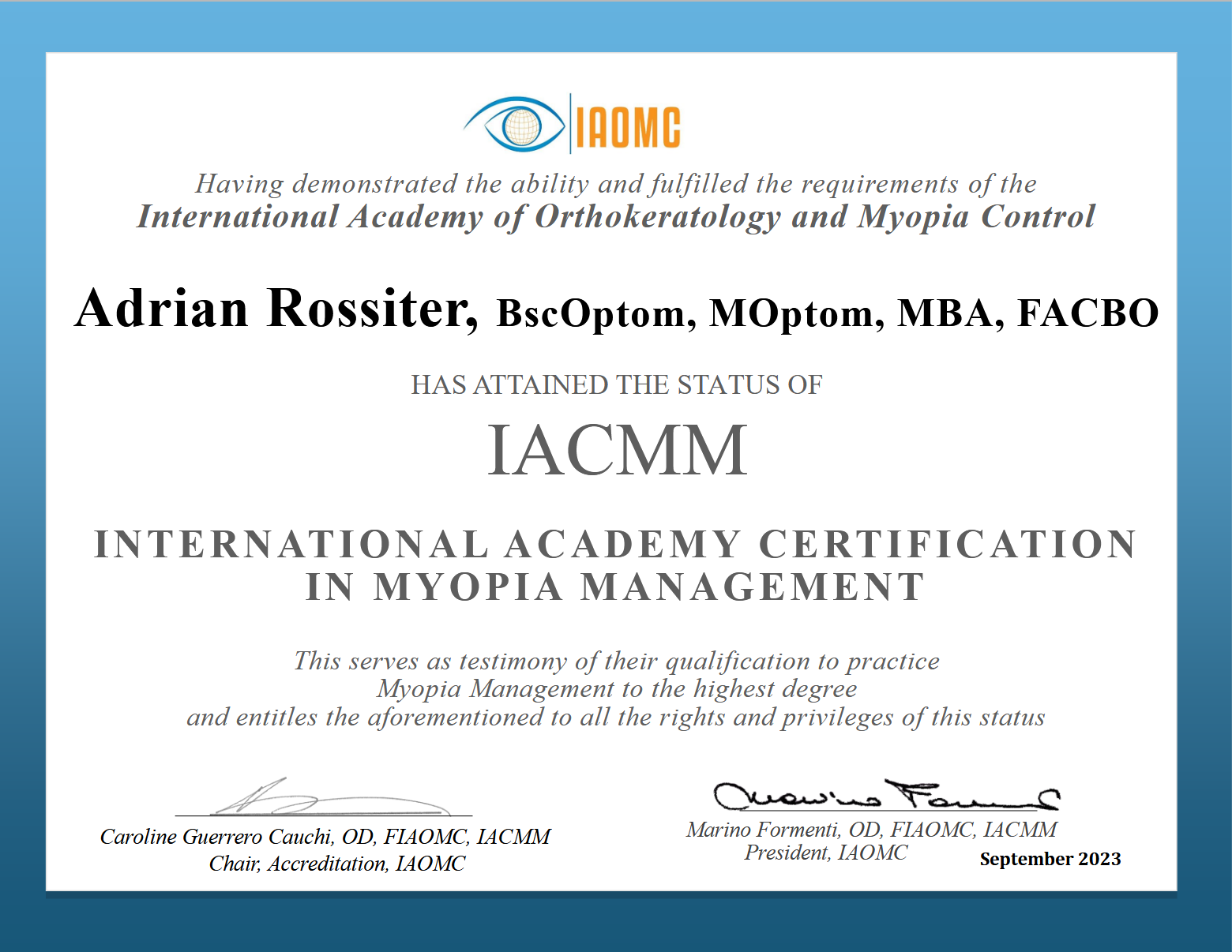How to Choose an Optometrist
To find the best optometrist, consider their experience, specialised training, technology they use, and your personal needs and preferences. Ask friends, family, or online communities for recommendations and then research potential optometrists, looking at their qualifications, experience, and reputation. Also factor in location, accessibility, and their opening hours.
Here are some factors to consider:
Experience and specialisation
Technology and services
Personal factors and recommendations
Initial contact
1. Experience and Specialisation:
Look for qualifications:
Review their website for the qualifications of their optometrists.
As a minimum, ensure that they have an Optometry (BSc(Optom)), Master of Optometry (MOptom) or Doctor of Optometry (OD) degree.
Example degree and qualification for paediatric eye care
In addition, they may have obtained additional qualifications such as IACMM which stands for The International Academy Certification in Myopia Management. This is an advanced accreditation offered by the International Academy of Orthokeratology & Myopia control (IAOMC) to individuals who have completed a comprehensive training program in myopia management and orthokeratology.
Certification for IACMM
The provides reassurance as to the optometry practice’s experience in paediatric optometry and children’s vision.
Consider experience:
Experience builds over time. An optometry practice that has been providing a diverse range of services over several years will have gained experience and knowledge of these services.
Think about your needs:
If you, or your children, have specific eye conditions or visual needs, research if the optometry practice specialises in those areas. For example, neurological conditions, dry eye treatments or myopia control for you or your child.
2. Technology and Services:
Ask about advanced equipment:
Consider whether the optometry practice that you are considering has access to advanced equipment so that you obtain all the relevant information or visual analysis when you present for an eye examination.
Examples of equipment are a wide field retinal scan to obtain a wide view of the back of your eye (retina), an OCT (Optical Coherence Tomography) to measure the layers of your retina, and a visual field tester (to assess any gaps in your visual field of view).
In addition, for children and myopia control does the optometry practice have access to equipment that can measure the axial length of the eye over time to show the effectiveness of myopia treatment protocols.
It is also ideal to have equipment that can track how your child’s eyes move as they read text.
Check for comprehensive services:
Does the practice offer a full range of services, including eye examinations, dry eye clinics, comprehensive diabetic screenings, paediatric optometry, neurological optometry, complex contact lenses, and potentially vision therapy?
3. Personal Factors and Recommendations:
Get recommendations:
Ask friends, family, teachers, other allied health professionals, or online communities for their experiences and opinions.
Consider your preferences:
Do you prefer a large chain or a smaller, independent optometry practice?
Choose someone you feel comfortable with:
A good rapport for you, or your child, with your optometrist can make a big difference in your overall experience.
4. Initial Contact:
Call the optometry practice:
Ask about their optometry practice, experience, and any specific services they offer. Assess the waiting time to see an optometrist and consider any billing charges.
Review the website:
Consider the services provided, frame range, any additional information on key topics in their blogs, and whether it includes frequently asked questions.
For example, if you are looking for complex contact lenses like Orthokeratology; how does it work, what’s involved in the process and is there a risk to your eye health.
Ask questions:
Call the optometry practice and inquire about their approach to eye examinations, prescription lenses, or specialised services that they offer within the practice.
Schedule a consultation:
If you're satisfied with your initial contact, schedule a consultation or eye exam.




